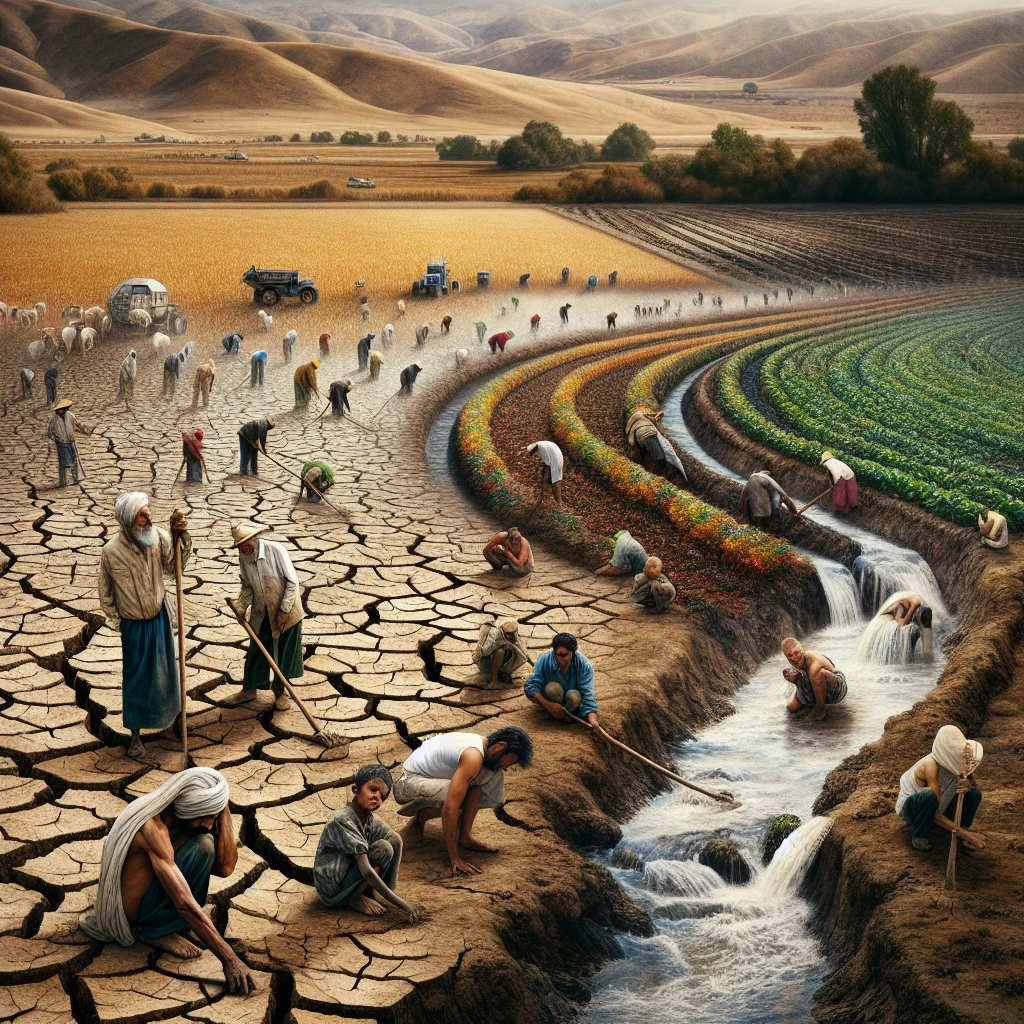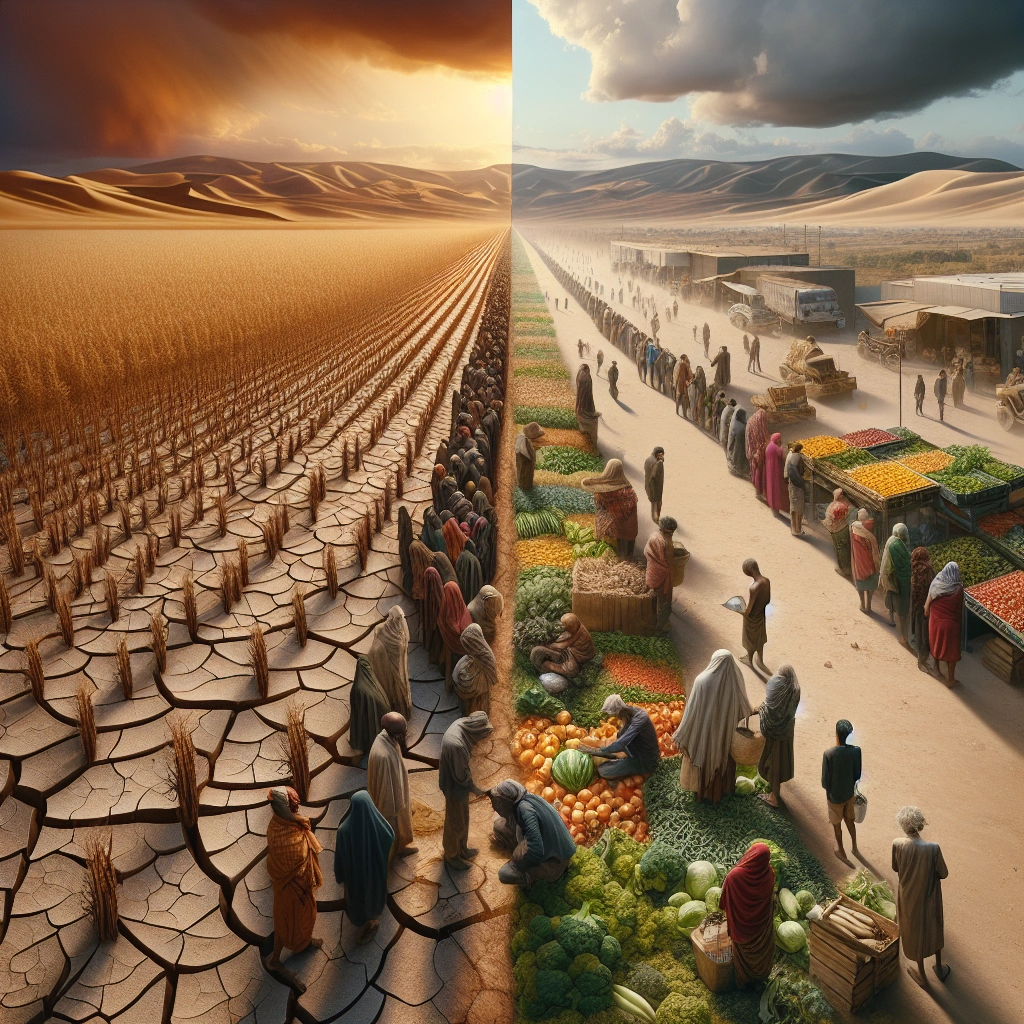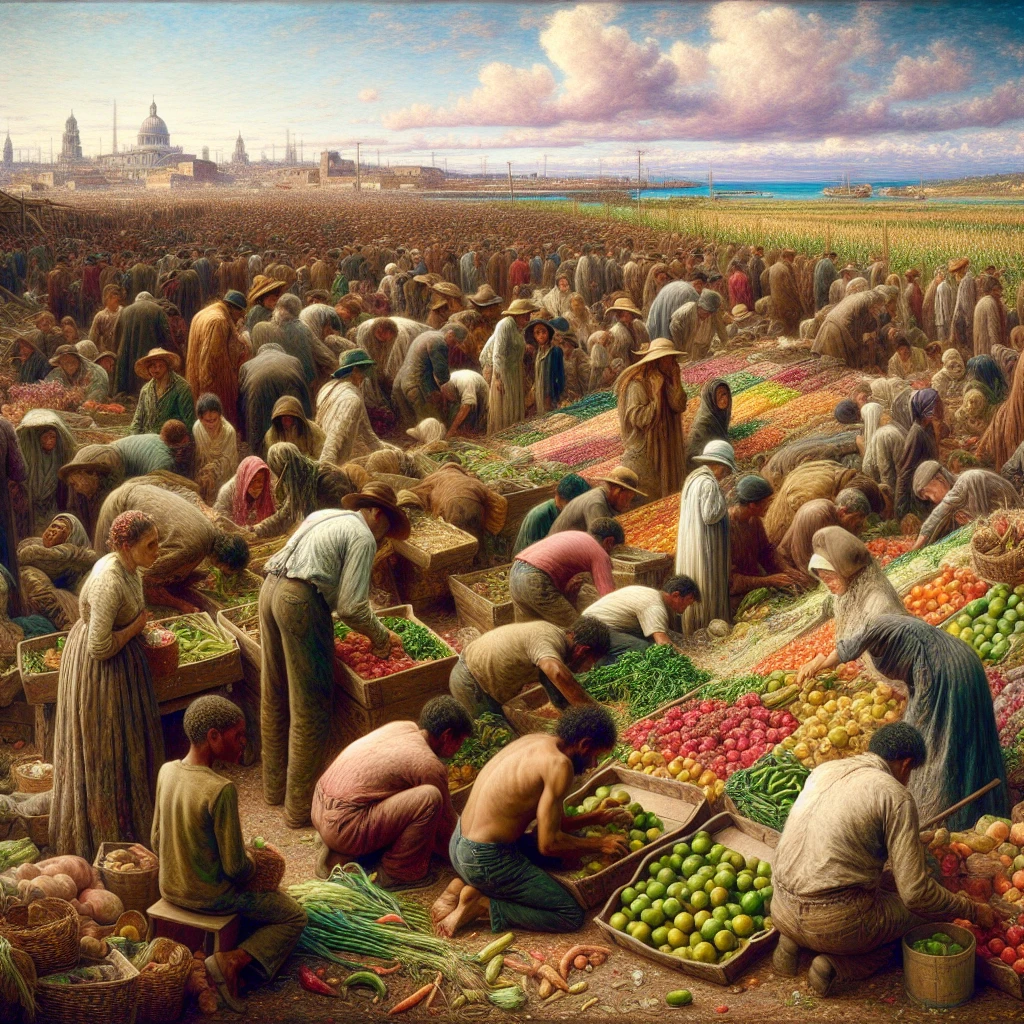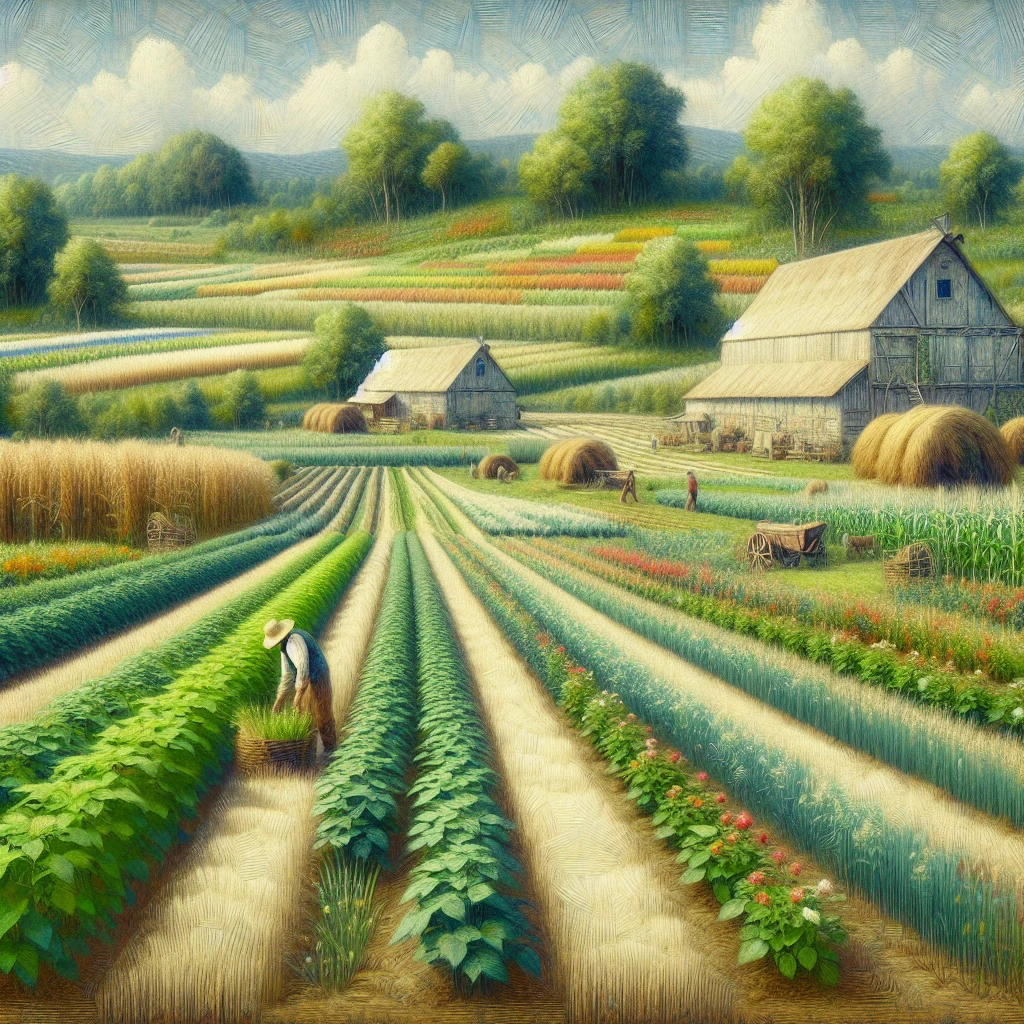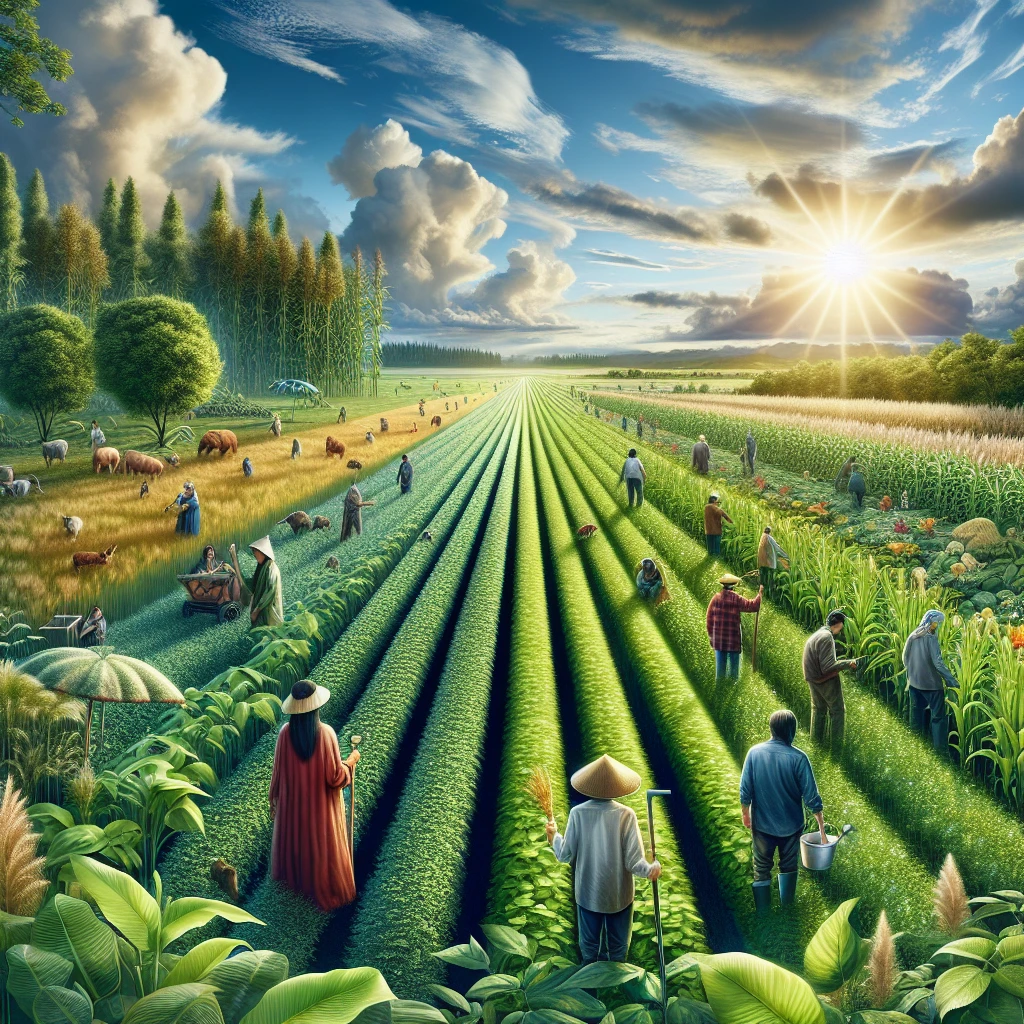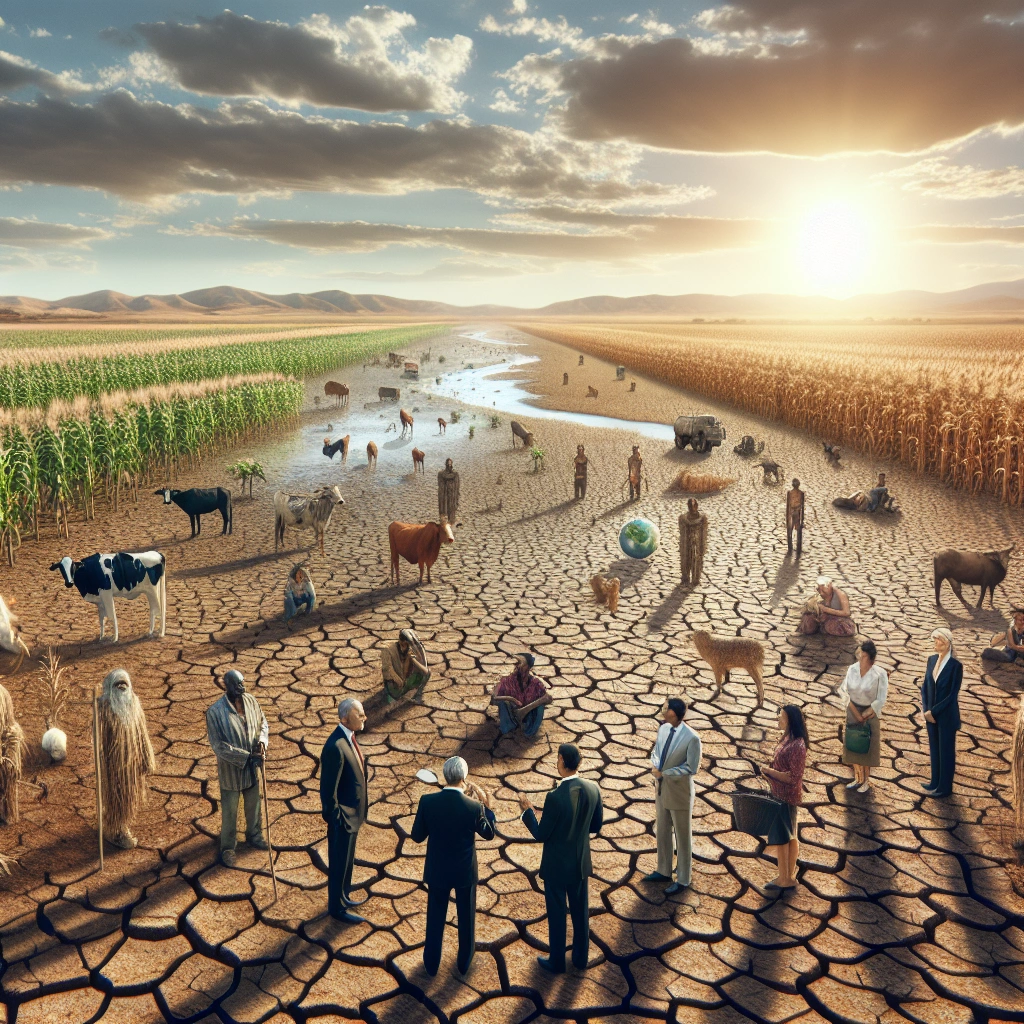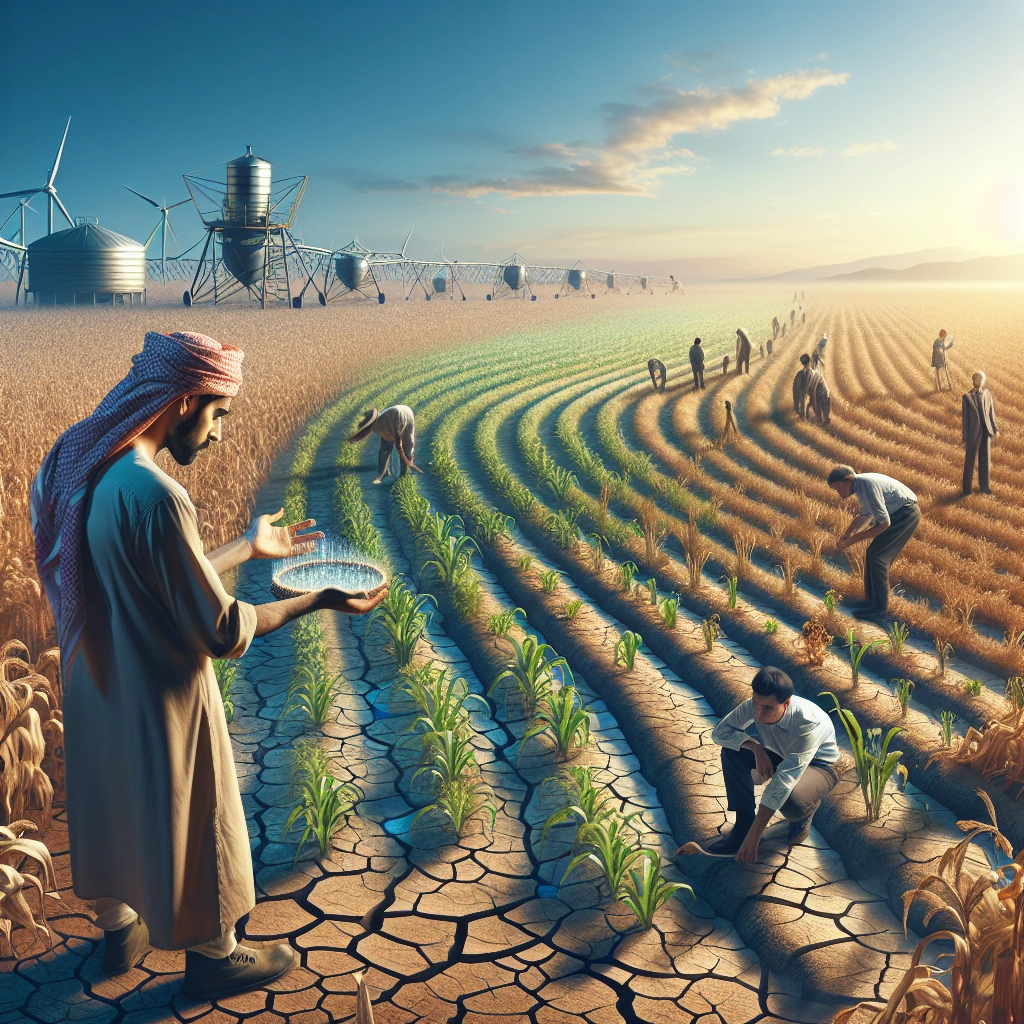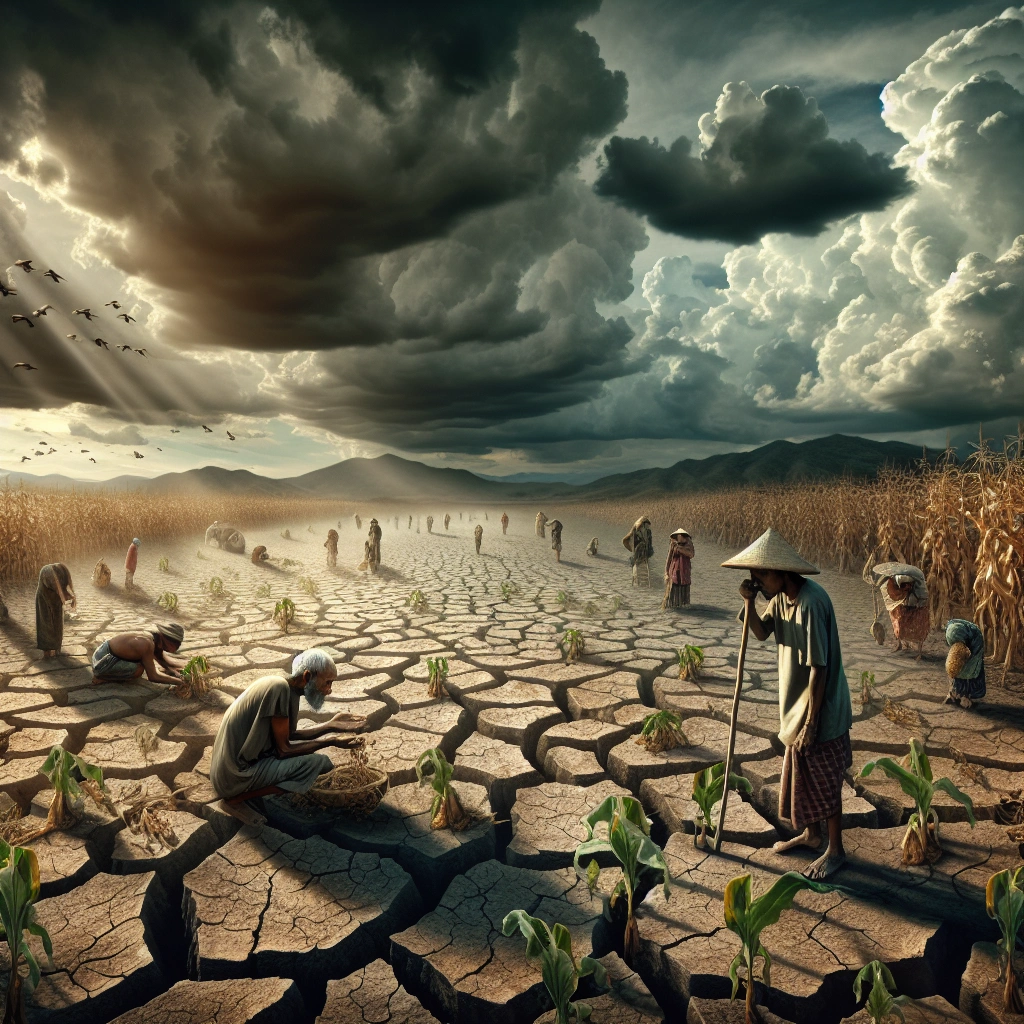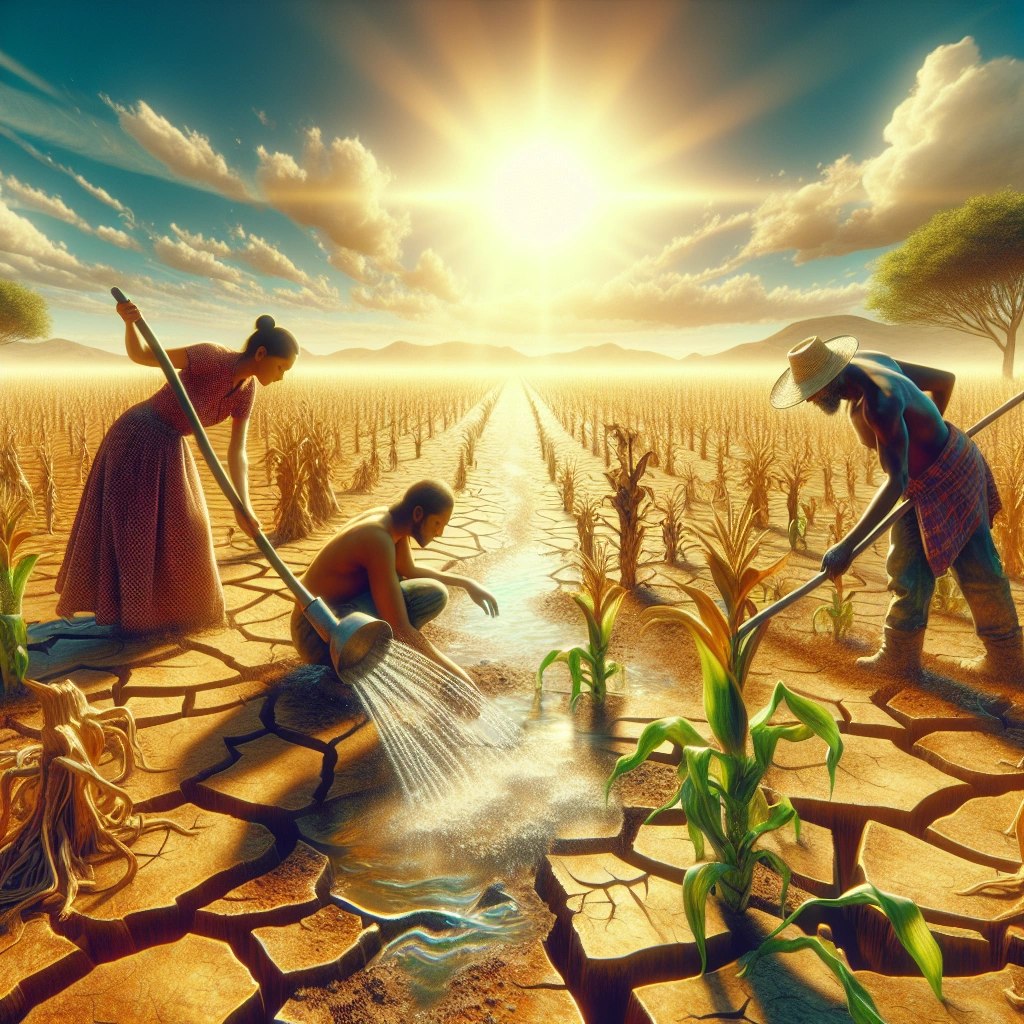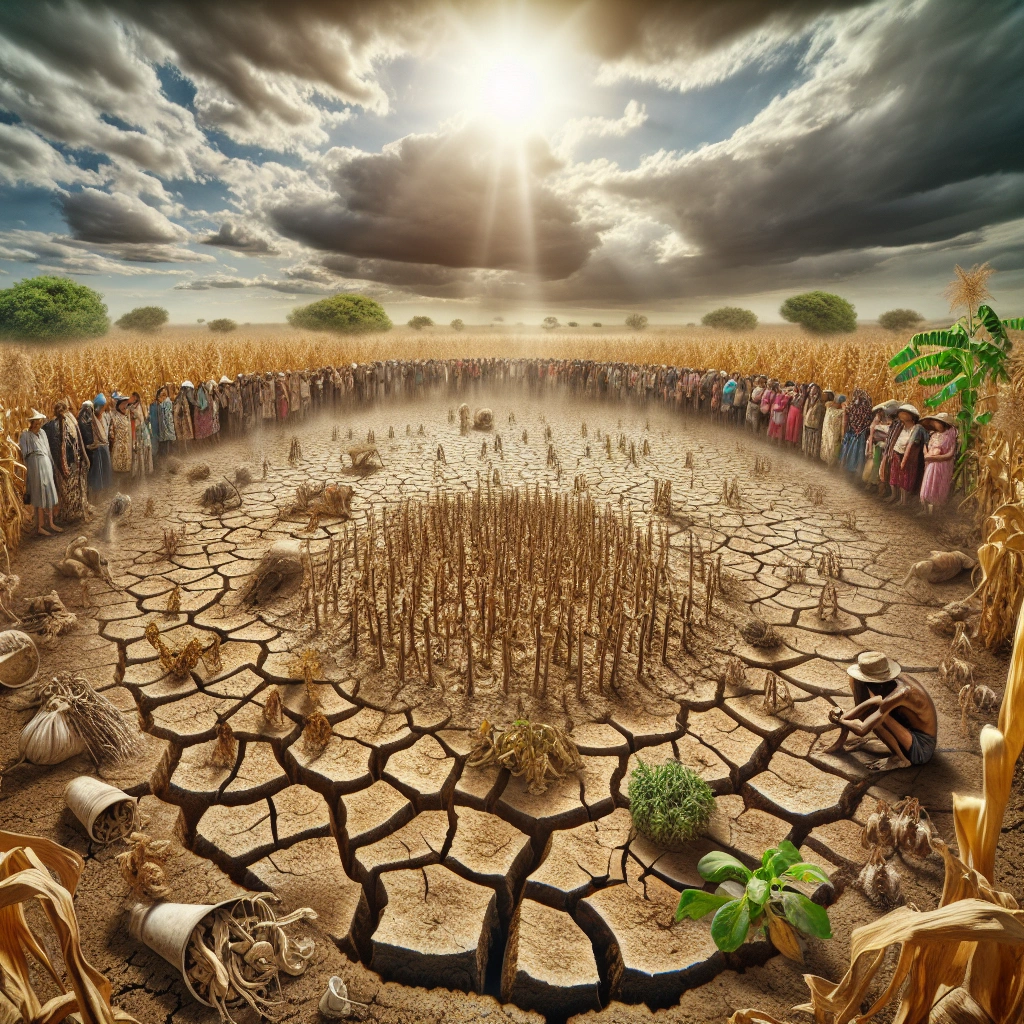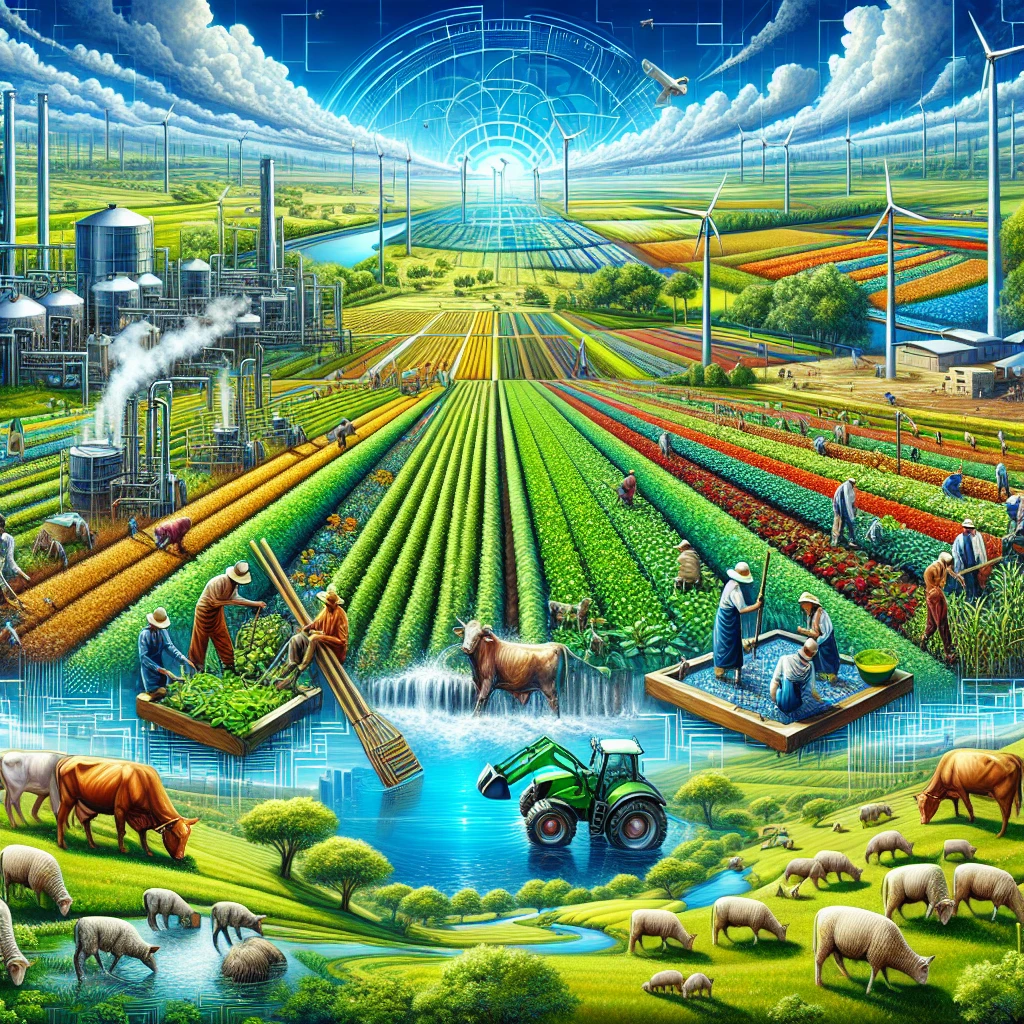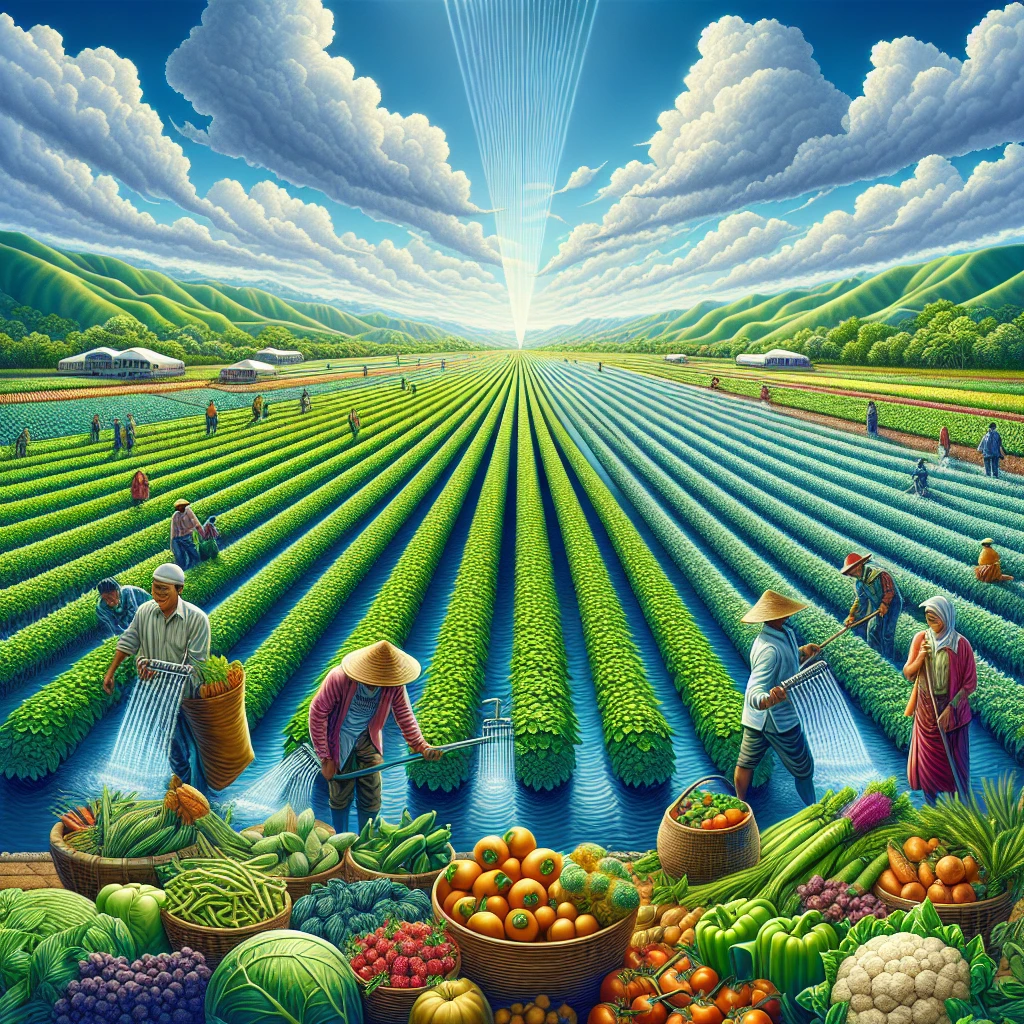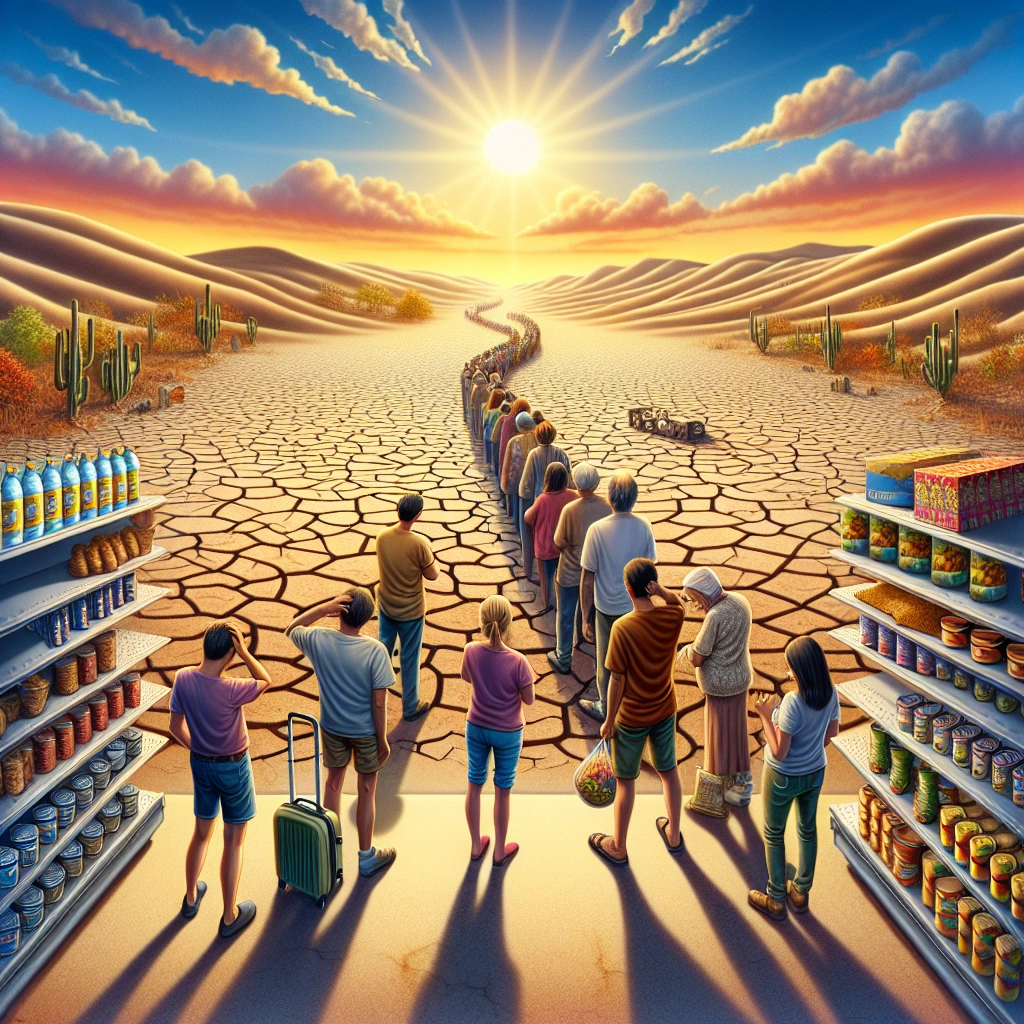

Global food security refers to the availability of and access to food in sufficient quantities to achieve adequate nutrition for the world population. Climate change is having a significant impact on global food security through disruptions in the food system, such as diminished water supplies, extreme weather events, heat stress, and increased prevalence of pests and diseases.
These impacts are leading to reduced food availability and access, thereby threatening food security worldwide.
Check out this Youtube video: “The impact of climate change on global food security – YouTube” to gain valuable insights on how climate change is affecting our global food supply and what actions can be taken to address this critical issue.
The Current State of Global Food Security
Statistics on global hunger and malnutrition
Global hunger and malnutrition have reached alarming levels, with over 783 million people suffering from chronic hunger worldwide as of 2022. This number is unprecedented and signals a worsening trend in food insecurity. Additionally, 40 million individuals are currently facing emergency levels of hunger across 51 countries. These statistics emphasize the urgent need for effective measures to address food insecurity on a global scale.
Factors contributing to food insecurity
Several factors contribute to the pervasive issue of food insecurity, including poverty, unemployment, low income, lack of affordable housing, chronic health conditions, systemic racism, and racial discrimination. Additionally, inadequate access to healthcare and insufficient, insecure incomes drive food insecurity, highlighting the multifaceted nature of this challenging problem.
It is crucial to recognize these interconnected factors to implement comprehensive strategies aimed at combating food insecurity.
Connection to climate change
The impact of climate change on global food security cannot be understated. Climate-related disruptions in the food system directly influence human health by diminishing food security, a crucial determinant of overall well-being.
The distribution of country food species is affected by environmental factors and new predators linked to climate change, exacerbating the challenges faced by food systems worldwide. Furthermore, climate phenomena and global warming significantly contribute to rising global food insecurity, emphasizing the intricate relationship between climate change and food security.
Therefore, efforts to address food insecurity must also consider and respond to the impacts of climate change on the global food supply.
| Country | Population at Risk of Food Insecurity |
|---|---|
| United States | 50 million |
| India | 190 million |
| Nigeria | 90 million |
| Brazil | 40 million |
The current state of global food security demands urgent attention and collective action to mitigate the impact of hunger and malnutrition. By addressing the factors contributing to food insecurity and acknowledging the connection to climate change, we can work towards establishing sustainable solutions and ensuring access to nutritious food for all individuals, thereby fostering a more secure and prosperous future for communities worldwide.
Effects of Climate Change on Agricultural Production
Changing weather patterns
Extreme weather events, such as floods and droughts, are becoming more frequent and severe due to climate change. These erratic weather patterns pose significant challenges for farmers as they can harm crops and reduce yields.
For example, heavy precipitation can erode soil and deplete nutrients, while extreme temperatures intensify drought stress, impacting crop growth.
Impact on crop yields and quality
Climate change is expected to affect crop yields and quality worldwide. Higher temperatures contribute to reduced crop yields in many regions, further exacerbating food insecurity.
Additionally, shifts in temperature and precipitation patterns may lead to changes in crop composition, affecting the nutritional quality and overall diversity of food sources.
Shifts in growing seasons
The length and timing of growing seasons are already being impacted by climate change. Earlier springs and extended growing seasons offer opportunities for greater agricultural yields in some regions.
However, these seasonal shifts also bring challenges, such as increased variability and the need for different farming practices to adapt to the changing climate.
| Climate Change Impact | Example |
|---|---|
| Erratic weather events | Increased flooding affecting crop growth |
| Reduced crop yields | Decreased wheat production due to higher temperatures |
| Changing growing seasons | Crop planting and harvesting shifting due to earlier springs |
Climate change is significantly influencing agricultural production by altering weather patterns, impacting crop yields and quality, and shifting growing seasons, presenting both opportunities and challenges for farmers worldwide.
Impact on Livestock and Fisheries
Stress on animal health and productivity
Climate change exerts significant stress on animal health and productivity, primarily through increased heat stress and impacts on forage and crop-based feeds. The intensity and duration of heat stress can cause metabolic disruptions, oxidative stress, and immune system impairments in livestock, affecting their overall health and welfare.
Disruption of fishing patterns and marine ecosystems
The impact of climate change on the world’s oceans is leading to the disruption of fishing patterns and marine ecosystems. Sudden rises in temperature and acidification are resulting in the loss of marine habitats and species, while warming waters and shifting ocean currents are altering the distribution and structure of fish stocks and marine ecosystems.
These changes are not only impacting marine life but also posing challenges for fisheries and fishing regulations.
Vulnerability of Small-scale Farmers
Lack of resources to adapt to changing conditions
Small-scale farmers often lack the financial capacity to invest in adaptive measures to cope with the changing climate. This includes purchasing drought-resistant seeds, investing in irrigation systems, or implementing sustainable farming practices.
Without adequate resources, these farmers face significant challenges in adapting to the unpredictable and extreme weather conditions brought about by climate change.
Economic impact on local food systems
The economic impact of climate change on local food systems is profound for small-scale farmers. Crop failures, reduced yields, and increased vulnerability to pests and diseases directly threaten their livelihoods.
Additionally, the fluctuating prices of staple crops due to climate-related disruptions further exacerbate the economic instability, making it difficult for small-scale farmers to sustain their agricultural activities and contribute effectively to local food security.
Access to Food and Distribution Challenges
Disruption of supply chains
The disruption of supply chains due to climate change impacts has led to challenges in ensuring the consistent flow of food from production to consumption. For example, extreme weather events such as hurricanes and floods have caused damage to infrastructure and agricultural lands, resulting in delays and shortages in food distribution.
Food price volatility
Climate change has contributed to food price volatility through its influence on agricultural productivity. For instance, prolonged droughts or excessive rainfall can reduce crop yields, leading to fluctuations in food prices.
This volatility poses challenges for consumers, as they experience unpredictable changes in the cost of essential food items.
Impact on vulnerable populations
Vulnerable populations, such as low-income communities and regions with limited access to resources, are disproportionately affected by the impact of climate change on food security. For example, reduced agricultural productivity can lead to food shortages in already marginalized areas, exacerbating food insecurity and malnutrition among vulnerable populations.
Climate Change and Food Waste
Spoilage due to extreme weather events
Extreme weather events, intensified by climate change, significantly contribute to the spoilage of food. For example, heatwaves can cause rapid spoilage of fresh produce, leading to substantial food loss.
Additionally, flooding can contaminate crops, rendering them unfit for consumption. These events disrupt the food supply chain, leading to shortages and impacting global food security.
Importance of reducing food waste to improve food security
Reducing food waste plays a vital role in improving food security on a global scale. By minimizing wastage at various stages of the food supply chain, including production, transportation, and consumption, more food can be made available to meet the world’s nutritional needs.
This reduction in waste not only addresses hunger and malnutrition but also minimizes the environmental impact through the conservation of resources and reduction of greenhouse gas emissions.
| Ways to Reduce Food Waste |
|---|
| 1. Adopt a healthier, sustainable diet |
| 2. Purchase only what is necessary |
| 3. Embrace imperfect-looking produce |
| 4. Ensure proper food storage |
| 5. Educate consumers on effective food management techniques |
These strategies contribute to enhancing food security and ensuring that food resources are utilized more efficiently, ultimately mitigating the adverse effects of climate change on global food security.
Agroecology and sustainable farming practices
Implementing agroecology in farming practices involves ecological contour hedgerows to reduce soil erosion, shade trees to mitigate higher temperatures for crops like coffee, wheat, and rice, and optimizing the landscape for sustainable agriculture.
Access to resilient crop varieties
The development and dissemination of high-yielding and disease-resistant crop varieties play a crucial role in addressing the challenges faced by farmers globally. Early-maturing cereal crop varieties, heat-tolerant varieties, and drought-tolerant legumes are some examples of climate-resilient crops that have been adopted.
Water management and irrigation techniques
Climate-resilient water management techniques play a vital role in sustainable agriculture, including the adoption of water-smart technologies such as furrow-irrigated raised beds, micro-irrigation, rainwater harvesting structures, and efficient irrigation techniques like drip irrigation and protected agriculture.
| Climate-Resilient Agriculture Solutions | Description |
|---|---|
| Agroecology and Sustainable Farming Practices | Agroecology practices like implementing ecological contour hedgerows, shade trees, and optimizing landscape for sustainable agriculture. |
| Access to Resilient Crop Varieties | Development and dissemination of high-yielding and disease-resistant crop varieties, including early-maturing cereal crop varieties, heat-tolerant varieties, and drought-tolerant legumes. |
| Water Management and Irrigation Techniques | Adoption of water-smart technologies such as micro-irrigation, rainwater harvesting structures, and efficient irrigation techniques like drip irrigation and protected agriculture. |
These innovative solutions contribute to climate-resilient agriculture, ensuring sustainable food production amidst the challenges posed by climate change.
It’s all about leveraging these innovative agricultural solutions to withstand the disruptive impacts of climate change and secure global food supply.
These are not just ordinary solutions; they are the keys to ensuring a resilient and sustainable future for agriculture in the face of climate change.
Implementing these innovative practices is the pathway to safeguarding global food security in an ever-changing climate landscape.
By embracing these climate-resilient solutions, we can revolutionize the way we approach agriculture, ensuring a more sustainable and secure food future for generations to come.
We’ll implement these solutions, and we’ll do it better than anyone else. We’ll make agriculture resilient and the envy of the world!
Policy and Governance Responses to Climate Change and Food Security
International agreements and initiatives
- The international community has undertaken significant agreements and initiatives to address the impact of climate change on food security.
- One such prominent agreement is the Paris Agreement, which aims to limit global warming to well below 2 degrees Celsius above pre-industrial levels and pursue efforts to limit the temperature increase to 1.5 degrees Celsius.
- Additionally, the Global Stocktake provides a comprehensive assessment of countries’ progress in reducing emissions and adapting to climate change, offering a roadmap to minimize harms to biodiversity and food security.
Government policies to address the impacts of climate change on food security
- Governments worldwide are implementing policies to mitigate the impact of climate change on food security, focusing on sustainable agricultural practices and resilient food systems.
- For instance, governments are investing in research and development of climate-resilient crop varieties and promoting sustainable land management practices to ensure food production in changing climatic conditions.
- Furthermore, policies are being formulated to reduce food loss and waste, conserving energy and resources while addressing climate change and enhancing food security.
Role of Technology in Addressing Food Security
Use of satellite technology for monitoring agricultural lands
Satellite technology plays a crucial role in monitoring agricultural lands by providing real-time data on crop health, temperature, and precipitation. For example, NASA’s Landsat program has enabled farmers to visualize and monitor crop health throughout the growing season, helping them identify concerns before a food security crisis materializes.
This technology empowers farmers to make informed decisions to enhance agricultural productivity and mitigate the impact of climate change.
Mobile applications for sustainable farming practices
Innovative mobile applications such as CropX, iAgri, and Climate FieldView are revolutionizing sustainable farming practices. These apps provide essential information on organic farming practices, crop cultivation, pest control, and soil management.
For instance, iAgri offers valuable insights for organic farming, while CropX and Climate FieldView help farmers optimize their crop management, thereby contributing to sustainable and efficient agricultural practices.
Access to climate information for farmers
Access to climate information services is vital for farmers to adapt to climate change and manage related risks. Digital Climate-informed Advisory Services aim to help small-scale agricultural producers better adapt to a more variable and changing climate by integrating climate information into agricultural decision-making.
Additionally, climate information is disseminated through radio, demand-driven extension, and mobile technology, enabling farmers to make informed decisions and adopt climate-resilient pathways for enhanced food security.
| Example Mobile Apps | Features |
|---|---|
| CropX | Optimizes crop management |
| iAgri | Offers organic farming insights |
| Climate FieldView | Assists in sustainable practices |
Let’s make agriculture great again by harnessing the power of technology to ensure food security for all!
Community Resilience and Adaptation
Importance of community-based adaptation strategies
Community-based adaptation strategies are vital in addressing the impacts of climate change on food security. By involving local communities in the identification and implementation of adaptation measures, we can ensure that solutions are tailored to the specific needs and challenges faced by each community. For instance, in low-lying coastal areas, communities could explore flood-resistant crop varieties or sustainable irrigation techniques to mitigate the effects of rising sea levels.
Building resilience through local food systems
Local food systems play a crucial role in building resilience against climate change’s impact on global food security. When communities prioritize locally sourced food, they reduce their dependence on distant food sources, decreasing vulnerability to supply chain disruptions caused by extreme weather events. For example, urban farming initiatives can provide immediate access to fresh produce, reducing the reliance on long-distance transport systems that are susceptible to climate-related disruptions.
Empowering vulnerable communities to address food security challenges
Empowering vulnerable communities to address food security challenges involves providing access to resources and knowledge that enable them to adapt and thrive in changing environmental conditions. For instance, offering training in sustainable agricultural practices and providing access to resilient crop varieties can empower communities to maintain food security despite unpredictable climate patterns. Additionally, improving infrastructure for food storage and distribution in vulnerable areas can enhance the resilience of these communities in the face of climate-related challenges.
Education and Awareness on Climate Change and Food Security
Importance of informing the public about the impact of climate change on food security
As we delve into the critical intersection of climate change and food security, it’s imperative to inform the public about the substantial impact of climate change on the global food supply. The erratic weather patterns and extreme events triggered by climate change directly affect agricultural productivity, leading to potential food shortages and price spikes.
By educating the public about these repercussions, we can foster a deeper understanding of the urgency to address climate change and its direct implications on food security.
Incorporating climate change and food security into education curricula
Integrating climate change and food security into education curricula is vital for cultivating a future generation equipped to tackle the challenges ahead. By incorporating these topics into school curricula at all levels, we can empower students with the knowledge and critical thinking skills to understand the intricate relationship between climate change and food security.
This proactive approach ensures that the next generation is well-prepared to contribute to sustainable solutions and resilient agricultural practices, ultimately mitigating the adverse impacts of climate change on global food security.
Collaborative Efforts for Sustainable Food Systems
Role of partnerships in addressing food security challenges
Partnerships play a vital role in addressing food security challenges by bringing together diverse expertise and resources. For instance, the collaboration between international organizations like the United Nations Food Systems Champions Network and the Global Alliance for the Future of Food has enabled the pooling of efforts to combat hunger and malnutrition. Additionally, public-private partnerships have proven effective in implementing market-based approaches, ultimately improving agri-food systems and reducing food insecurity. Such collaborative efforts underscore the significance of partnerships in developing sustainable solutions for food security challenges.
Stakeholder engagement in developing climate-resilient food systems
Engaging stakeholders in developing climate-resilient food systems is essential for fostering transformative change. Cross-sector partnerships involving stakeholders from research centers, agricultural organizations, and private sectors are pivotal in promoting innovative science, developing resilient crops, and advocating good agricultural practices. Furthermore, such engaged stakeholders can help integrate sustainable practices into business strategies and create adaptive measures to address climate risks and opportunities. This active involvement of stakeholders emphasizes the critical role they play in shaping climate-resilient food systems.
| Pros of Partnerships in Addressing Food Security Challenges | Cons of Partnerships in Addressing Food Security Challenges |
|---|---|
| Enhanced pooling of expertise and resources | Potential conflicts of interest leading to inefficiencies |
| Promotion of innovative and market-based solutions | Challenges in achieving consensus and decision-making |
| Improved coordination and implementation of solutions | Risk of unequal power dynamics and conflicting agendas |
In essence, partnerships and stakeholder engagement are crucial for catalyzing sustainable change and resilience within global food systems to mitigate the impacts of climate change and ensure food security for the future.
The Importance of Diverse Diets in Addressing Food Insecurity
Promoting nutrition-sensitive agricultural practices involves incorporating nutrition promotion and education around food and sustainable food systems while leveraging existing local knowledge, attitudes, and practices. This approach recognizes the vital role of diverse, micronutrient-rich crops, dairy, and small animal rearing in enhancing the production and consumption of essential commodities.
Furthermore, the role of diversified diets in enhancing food security and resilience cannot be overstated. Embracing diverse and healthy diets, primarily plant-derived, is crucial for reducing diet-related illnesses and fostering resilience within food systems.
Consuming products from a wide range of species, varieties, and breeds helps to ensure that diets contain all the necessary vitamins and minerals for a healthy life.
Economic Impacts of Climate Change on Food Security
Cost of adaptation and mitigation strategies
The economic impacts of climate change on food security are substantial, with the cost of adaptation and mitigation strategies being a key consideration. Assessing the costs and benefits of climate change adaptation is crucial. For instance, adaptation actions are considered cost-efficient when the benefit-cost ratio exceeds 1.5. This emphasizes the importance of carefully evaluating measures that result in a lower ratio to ensure effective resource allocation.
Economic losses due to climate-related impacts on agriculture
The economic losses resulting from climate-related impacts on agriculture are alarming. The Climate Policy Initiative revealed that the world only spends under $50 billion on adaptation a year, which is less than 10% of overall climate investments.
Additionally, estimates indicate that the adaptation finance gap for developing countries is widening, with adaptation costs being five to ten times greater than current public adaptation finance flows. These findings underscore the pressing need to address and mitigate economic losses in agriculture due to climate change.
Ethical and Social Justice Considerations
Disproportionate impact on marginalized communities
Disproportionate impacts of climate change on marginalized communities are evident in the increased vulnerability of underserved populations to extreme weather events and environmental degradation. These communities often lack the financial resources to adapt and recover from the adverse effects of climate change, leading to heightened risks of food insecurity and displacement.
Relocation, which may become necessary due to environmental disasters, poses significant economic and spiritual challenges, particularly for Indigenous groups deeply connected to their land.
Intersection of climate change, food security, and social equity
The intersection of climate change, food security, and social equity reveals a complex web of intertwined challenges. For areas already facing water scarcity, climate change exacerbates agricultural production challenges through water supply constraints, extreme weather events, heat stress, and heightened prevalence of pests and diseases.
This directly impacts food availability and access, contributing to food insecurity and vulnerability, especially among marginalized communities. Furthermore, climate-related disruptions in the food system can have indirect impacts on human health by influencing food security, a crucial determinant of overall well-being.
| Climate Change Impact | Specifics |
|---|---|
| Water Supply | Diminishing water supplies adversely affect agricultural production. |
| Food Availability | Climate-related disruptions lead to shortages and decreased access to food. |
| Human Health | Indirect impacts on health through diminished food security. |
Addressing the ethical and social justice considerations related to climate change’s impact on global food security underscores the urgent need for prioritizing the resilience of marginalized communities and fostering equitable access to essential resources. The intricate relationship between climate change, food security, and social equity necessitates comprehensive and inclusive strategies that empower vulnerable populations to adapt and thrive in the face of environmental challenges.
Recommended Amazon Products for Improving Climate-Resilient Agriculture
Here’s a curated list of products that can help you improve climate-resilient agriculture with ease. These recommendations are based on functionality, price, and reviews.
Greenworks 20-Inch 40V Twin Force Cordless Lawn Mower
The Greenworks 20-Inch 40V Twin Force Cordless Lawn Mower is a powerful and efficient tool for maintaining your agricultural land. With dual blades and a 40V lithium-ion battery, it offers excellent functionality for mowing and trimming. The product has received high ratings for its performance and ease of use. You can find the product on Amazon at Greenworks 20-Inch 40V Twin Force Cordless Lawn Mower.


| Pros | Cons |
|---|---|
| Powerful performance | Price may be higher compared to other models |
| Cordless operation | Battery may need periodic replacement |
| Dual blades for efficient cutting | Requires storage space for the mower |
Burpee Ultimate Seed Starting Kit
The Burpee Ultimate Seed Starting Kit provides everything you need to start your crop production indoors. It includes seed starting mix, a greenhouse dome, and a seedling heat mat for optimal germination conditions. The kit has received positive reviews for helping users kickstart their gardening efforts. You can find the product on Amazon at Burpee Ultimate Seed Starting Kit.


| Pros | Cons |
|---|---|
| Complete kit for seed starting | Price may be a bit high for beginners |
| Creates ideal germination conditions | Limited capacity for larger-scale operations |
| User-friendly for gardening enthusiasts | Requires subsequent transplanting of seedlings |
Housolution Gardening Tote Bag
The Housolution Gardening Tote Bag is a durable and versatile tool for carrying gardening supplies and produce. With multiple pockets and a sturdy construction, it offers convenience and ease of use for various gardening tasks. The product has received positive feedback for its practical design and usefulness. You can find the product on Amazon at Housolution Gardening Tote Bag.


| Pros | Cons |
|---|---|
| Spacious and organized storage | May not be essential for all agricultural operations |
| Durable and lightweight | Limited to carrying gardening-related items |
| Versatile for various gardening tasks | May not be suitable for larger-scale operations |
Flexzilla Garden Hose
The Flexzilla Garden Hose is a high-quality and flexible hose that provides efficient watering for your crops and plants. With its durable construction and kink-resistant design, it offers ease of use and longevity. The product has received excellent reviews for its performance and reliability. You can find the product on Amazon at Flexzilla Garden Hose.


| Pros | Cons |
|---|---|
| Flexible and kink-resistant | Price may be higher compared to standard hoses |
| Durable construction | Limited to watering-related tasks |
| Reliable performance | Requires storage space for the hose |
Earthway 2050P Estate Broadcast Walk-Behind Seeder
The Earthway 2050P Estate Broadcast Walk-Behind Seeder is a precision tool for accurate and efficient seeding on your agricultural land. Its durable construction and precise calibration make it an essential product for sowing various seed types. The product has received positive feedback for its superior performance and ease of use. You can find the product on Amazon at Earthway 2050P Estate Broadcast Walk-Behind Seeder.


| Pros | Cons |
|---|---|
| Accurate and efficient seeding | Price may be high for occasional use |
| Durable and sturdy design | Requires occasional maintenance |
| Easy calibration for different seeds | Limited to seeding-related tasks |
Top Recommended Product for Improving Climate-Resilient Agriculture
If you’re looking for the best solution for improving climate-resilient agriculture, we highly recommend the Greenworks 20-Inch 40V Twin Force Cordless Lawn Mower. Here’s why:
The Greenworks 20-Inch 40V Twin Force Cordless Lawn Mower offers powerful performance and efficient mowing capabilities to maintain agricultural land. With dual blades and cordless operation, it provides convenience and reliability. The product has received high ratings for its functionality and ease of use. Ready to improve your agricultural practices? Check out Greenworks 20-Inch 40V Twin Force Cordless Lawn Mower today for the best results!


Conclusion
Climate change is impacting global food security through extreme weather events, affecting crop production and food supply. Rising temperatures and changing precipitation patterns are leading to decreased agricultural productivity and crop losses in many regions.
The increasing frequency and intensity of droughts, floods, and storms are causing food shortages, price spikes, and reduced access to nutritious and affordable food for vulnerable populations.
Governments, organizations, and communities must take urgent action to address the impact of climate change on global food security. This includes implementing sustainable agricultural practices, improving water management, and investing in climate-resilient crops.
Additionally, there is a need for collaborative efforts to reduce greenhouse gas emissions and mitigate the effects of climate change on food production and distribution. It is essential to prioritize the needs of small-scale farmers and marginalized communities who are most at risk of food insecurity due to climate change.
Addressing the impact of climate change on global food security requires a comprehensive and coordinated approach. We must prioritize sustainable solutions that promote resilience and adaptation in the face of changing climatic conditions.
It is crucial for all stakeholders to work together to ensure food security for current and future generations, especially in the most vulnerable regions that are disproportionately affected by the consequences of climate change.

